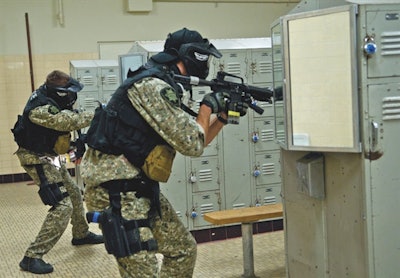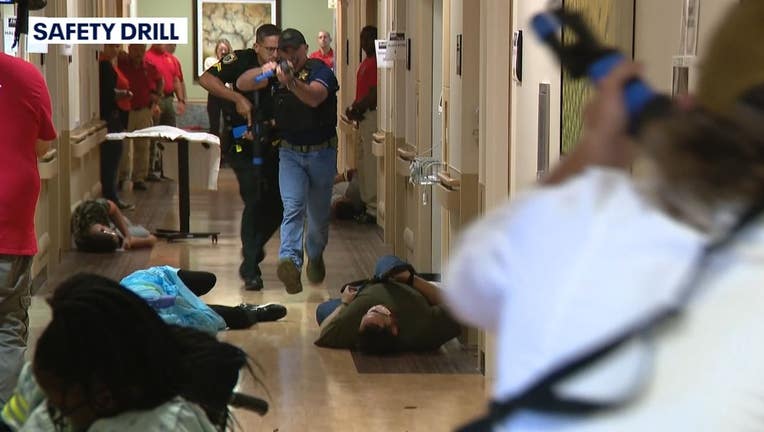Reliable Techniques and Strategies in Energetic Shooter Training for Boosted Safety
In today's ever-evolving protection landscape, the value of readiness and efficient action techniques when faced with energetic shooter events can not be overemphasized. Organizations, organizations, and people must equip themselves with the needed devices and expertise to alleviate threats and protect lives in such important scenarios. From comprehensive risk assessments and dilemma communication plans to hands-on situation drills and medical training, a multi-faceted technique is important. Just having these parts in location is not sufficient; the key lies in their smooth combination and real-world application. By delving right into the intricacies of each of these aspects and checking out just how they can function in harmony, a much more durable and effective energetic shooter training program can be created to improve security procedures.
Threat Analysis and Risk Evaluation
Effective danger assessment and detailed risk analysis are foundational components in boosting security measures throughout energetic shooter training programs. By carrying out an extensive danger evaluation, companies can recognize potential vulnerabilities and establish targeted strategies to alleviate dangers associated with active shooter cases. This procedure involves evaluating aspects such as center design, access points, protection systems, and emergency situation methods to produce an in-depth understanding of the particular threats encountered by the company.
Threat evaluation plays a critical role in active shooter training programs by determining potential opponents, their capacities, and their intents. This info is used to make practical training scenarios that simulate the tactics and behaviors of potential assaulters, enabling participants to exercise appropriate reactions in a controlled environment. By including danger evaluation right into training exercises, organizations can better prepare their employees to identify and respond successfully to energetic shooter situations.
Crisis Communication and Feedback Plans
In light of the detailed risk analysis and complete hazard analysis carried out throughout active shooter training programs, an important element that organizations must resolve is the growth of crisis interaction and feedback plans. These plans are vital for guaranteeing a collaborated and effective reaction to an active shooter scenario, lessening possible damage to people, and boosting overall security measures.
Effective situation communication plans must detail clear protocols for distributing info to all stakeholders, including workers, visitors, law enforcement, and the media. Prompt and accurate communication is essential in handling the circumstance, supplying directions on exactly how to remain risk-free, and stopping panic or misinformation from dispersing.
Response plans, on the other hand, detail the particular actions that people ought to absorb the event of an energetic shooter incident. This consists of procedures for lockdowns, discharges, shielding in position, and connecting with regulation enforcement upon their arrival. Normal training, drills, and updates to these plans are important to guarantee their effectiveness and the security of every person entailed. Organizations has to focus on the advancement and routine review of these critical plans to enhance their general security stance when faced with potential hazards.
Active Shooter Circumstance Drills
Carrying out normal active shooter scenario drills is vital for preparing organizations and people to react efficiently in high-stress circumstances. These drills replicate real-life active shooter scenarios, permitting participants to exercise their reactions and examine the performance of their training and emergency situation procedures (active shooter training). By carrying out these drills, people can acquaint themselves with the noise of substitute shooting, method helpful hints lockdown procedures, discharge courses, and communication strategies
Active shooter scenario drills additionally assist in identifying possible weak points in security steps and feedback strategies. With these simulations, organizations can analyze the effectiveness of their protection methods, communication systems, and control amongst personnel. Carrying out these drills routinely can aid in refining existing treatments, applying improvements, and guaranteeing that all people are prepared to act quickly and decisively in the occasion of an energetic shooter incident.

Emergency Situation Medical Training and First Aid
Enhancing readiness for emergency situations, consisting of active shooter occurrences, demands extensive training in emergency clinical treatments and very first help. In the event of an energetic shooter circumstance, people learnt emergency situation medical procedures can provide vital support to those harmed up until expert clinical help gets here. Emergency treatment training equips people with the understanding and skills to carry out instant care, maintain people, and possibly save lives.
Key elements of emergency situation medical training include discovering how to control bleeding, apply tourniquets, carry out CPR, and deal with numerous wounds. Participants also learn exactly how to prioritize care based on the seriousness of injuries and the offered resources. Furthermore, training in initial help assists people continue to be tranquil and focused during disorderly circumstances, enabling them to make fast and educated decisions under stress.

Emotional Support and Trauma Care
Offering emotional assistance and injury treatment is essential Discover More in alleviating the emotional effect of emergency situation situations, such as active shooter occurrences. When people experience such terrible occasions, they might struggle with a variety of mental distress, including anxiousness, depression, and trauma (PTSD) Consequently, it is vital to have actually trained professionals readily available to use prompt support and interventions to assist individuals manage the results of such situations.
Mental initial aid is a key part of reacting to energetic shooter occurrences. This approach includes giving useful help, psychological assistance, and dealing techniques to those influenced by the injury. By addressing the mental needs of people without delay, the likelihood of long-lasting unfavorable results can be reduced, and individuals can start the procedure of healing and recuperation.
In addition to instant psychological support, continuous trauma care is vital for those affected by energetic shooter cases. This might involve accessibility to therapy solutions, support groups, and other resources to assist people browse the facility emotions and difficulties that can arise adhering to such traumatic occasions. By focusing on emotional assistance and injury treatment in active shooter training programs, companies can much better prepare individuals to manage the emotional consequences of such emergency situations.
Conclusion
To conclude, effective methods and methods in energetic shooter training play a vital duty in improving safety and security procedures. By performing danger evaluations, establishing dilemma communication strategies, practicing energetic shooter situation drills, providing emergency medical training, and providing emotional assistance, organizations can much better prepare for and react to such critical cases. It is crucial for all stakeholders to be aggressive in applying these measures to ensure the safety and well-being of people in a prospective active shooter situation.
By delving right into the intricacies of each of these aspects and discovering exactly how they can work in More about the author consistency, an extra robust and effective active shooter training program can be developed to enhance safety measures.
Efficient threat evaluation and comprehensive threat evaluation are fundamental aspects in improving security actions throughout energetic shooter training programs. These drills replicate real-life energetic shooter circumstances, enabling participants to practice their responses and evaluate the effectiveness of their training and emergency procedures. By prioritizing psychological support and injury treatment in energetic shooter training programs, organizations can much better prepare people to deal with the psychological after-effects of such emergency situations.
In final thought, reliable approaches and methods in energetic shooter training play an essential role in improving security steps.